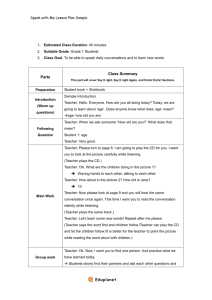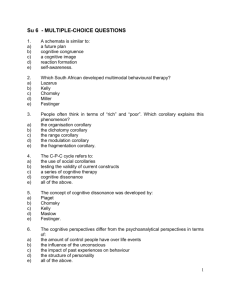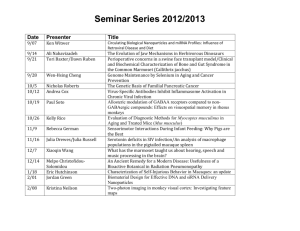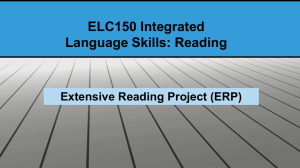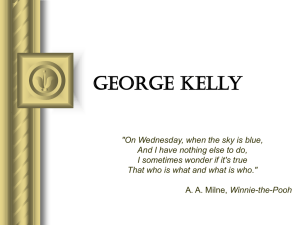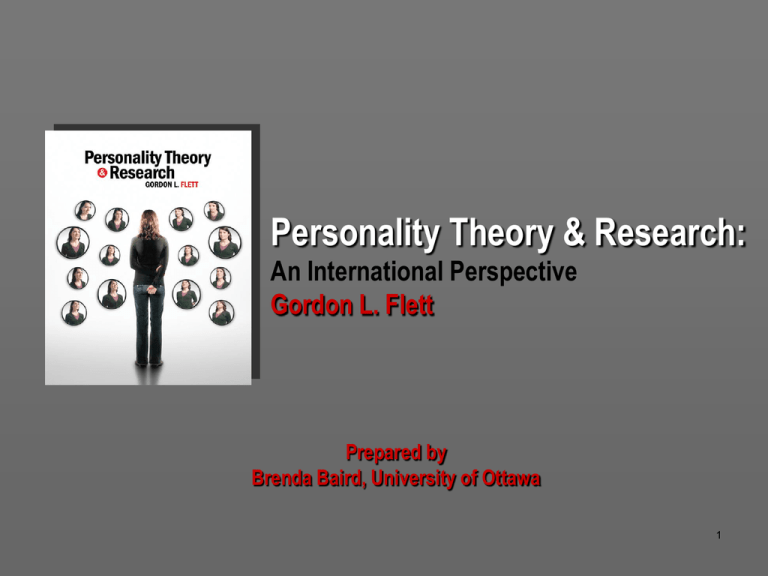
Personality Theory & Research:
An International Perspective
Gordon L. Flett
Prepared by
Brenda Baird, University of Ottawa
1
Chapter 9 Overview
•
•
•
•
•
•
George Kelly’s Personal Construct Theory
Kurt Lewin’s Cognitive and Field Theory of
Personality
Cognitively Based Personality Differences
The Need for Cognition
Attributions
Cognitive Rigidity
2
George Kelly’s Personal
Construct Theory
•
Constructs are cognitive categories with
personal meaning that guide interpretations of
life events
Kelly viewed constructs as bipolar with
implicit and explicit ends
Kelly outlined three constructs that vary in
levels of awareness in consciousness:
•
•
1.
2.
3.
Preverbal: tip-of-the tongue
Submerged: one or both poles are not
conscious
Suspended: current events preclude memory of
prior ones
3
George Kelly’s Personal
Construct Theory
The Person as Scientist
• Kelly used the metaphor of scientist to
describe each person’s motivation to make
sense of life events
• Anxiety results when information cannot be
integrated with our personal constructs
• Failure to update constructs produces hostility
• Constructive alternativism describes how two
people can have different views of the same
event or to a person's changing perception of
the same event over time
4
George Kelly’s Personal
Construct Theory
Kelly’s Corollaries
• Kelly fundamental postulate states that our
processes are psychologically directed by
our anticipation of events
• Constructs provide a cognitive map for
directing future behaviour based on our
anticipations of outcomes
5
George Kelly’s Personal
Construct Theory
Kelly’s Corollaries
• Kelly derived several principles from his
fundamental postulate:
–
–
–
–
–
–
–
–
–
–
–
Construction corollary
Range corollary
Individuality corollary
Experience corollary
Organization corollary
Modulation corollary
Dichotomy corollary
Fragmentation corollary
Choice corollary
Commonality corollary
Sociality corollary
6
George Kelly’s Personal
Construct Theory
Personal Constructs of the Unabomber
• Kelly’s theory was used to help depict a
construction system of the Unabomber
based on analyses of the bomber’s
published Manifesto
7
George Kelly’s Personal
Construct Theory
8
George Kelly’s Personal
Construct Theory
Empirical Research on the Nature of Personal
Constructs
• An idiographic research approach is best
for describing and understanding constructs
• Mischel (1964) noted that a nomothetic
approach would not enable prediction or
promote an understanding of individual
differences among people
9
George Kelly’s Personal
Construct Theory
Jack Adams-Webber
• Adams-Webber investigated Bieri’s (1955)
notion of cognitive complexity which refers
to the structure rather than the content of
cognitions
• Cognitive complexity is also termed
integrative complexity due to the distinction
between differentiated and integrated
dimensions of an issue
• Adams-Webber also supported Crockett’s
(1965) familiarity hypothesis
10
George Kelly’s Personal
Construct Theory
Roles and Fixed Role Therapy
• Kelly defined a role as a person’s pattern
of behaviour that stems from the views
held by an another, associated person
• The goal of therapy is to improve and
strengthen self constructs
• Kelly’s fixed role therapy allows the client
to see the world from another's view by
adopting their constructs
11
George Kelly’s Personal
Construct Theory
Roles and Fixed Role Therapy
• The actor–observer attribution bias refers
to the finding that negative events are
attributed to internal characteristics of
others, but to external events for the self
• Karst and Trexler (1970) found that fixed
role therapy led to greater improvements in
anxiety compared to rational-emotive
therapy
12
George Kelly’s Personal
Construct Theory
Roles and the Person-Situation Interaction
• Cattell (1963) suggested that life roles need
to be included in the person-situation
interaction
• Cultures may differ in the nature, relevance,
and influence of roles
• Research has found self- perceptions vary
across social roles in middle aged females,
and levels of perfectionism vary across life
domains for working mothers
13
George Kelly’s Personal
Construct Theory
The Role Construct Repertory Test and
Repertory Grids
• The Rep test requires respondents to name
15 people in each of 15 categories
• Respondents then identify several threeperson sets and describe how one person
differs from the other two
• These descriptions are analyzed for
constructs that emerge as themes identified
by Repertory Grids
14
George Kelly’s Personal
Construct Theory
15
George Kelly’s Personal
Construct Theory
The Role Construct Repertory Test and
Repertory Grids
• Rep tests come in alternative forms such as
Crockett’s (1982) Role Category
Questionnaire
• Rep Grids have been used in research, and
also have practical application such as
identifying constructs associated with
psychopathology
16
George Kelly’s Personal
Construct Theory
Kelly’s Contemporary Influence
• Kelly's’ work helped advance the cognitive
perspective and has led to the to
development of constructivist psychology
• One issue that is debated is whether Kelly
is a cognitive theorist or a humanistic
theorist due to his emphasis on personal
choice and meaning in life
17
George Kelly’s Personal
Construct Theory
Evaluation of Kelly
• Kelly promoted a focus on the whole
person
• Kelly’s use of constructs helped to advance
the cognitive revolution
• Critics note the focus on structure vs.
content of personality
• Other criticisms include the dichotomous
nature of constructs
18
Kurt Lewin’s Cognitive and Field
Theory of Personality
• Lewin is noted for his Gestalt approach to
personality with an emphasis on unity rather
than constituent parts
• Lewin distinguished between an
environmental situation and a psychological
situation
• Lewin’s concept of life space refers to a
person’s psychological field, composed of all
possible internal and external events that
can be topographically depicted
19
Kurt Lewin’s Cognitive and Field
Theory of Personality
20
Kurt Lewin’s Cognitive and Field
Theory of Personality
• The life space has separate fields that bear
a similarity to constructs
• The life space includes goals that are a
function of one’s expectancy of attainment
and incentive value
• Lewin emphasized that tensions shape
behaviour, and produce an inner drive
called force
21
Kurt Lewin’s Cognitive and Field
Theory of Personality
Lewin outlined six changes in personality
structure that occur over time:
1. Differentiation
2. Complexity
3. Expansion
4. Rigidity
5. Realism
6. Integration
22
Cognitively Based Personality
Differences
• Current research investigates personality
differences in information processing and
memory
• Some studies examine differences in the
ability of extroverts vs. introverts to
remember future (prospective memory) or
past events (episodic memory)
• Episodic memory is revealed through recall
of life events (autobiographical memories)
that are more easily remembered if
emotionally charged (flashbulb memories)
23
Cognitively Based Personality
Differences
Field dependence versus Field Independence
• Herman Witkin identified a cognitiveperceptual individual difference variable
while observing pilots
• Specifically, people either rely on global
aspects in the environment (field
dependent) or on specific details (field
independent) to perceptually orient
themselves
24
Cognitively Based Personality
Differences
Field dependence versus Field Independence
• There are three tests to measure field
dependence or independence:
1. The Rod and Frame test
2. The Embedded Figures Test
3. The Body Adjustment Test
• Witkin (1967) linked extroversion with
field dependence and introversion with
field in dependence
25
Cognitively Based Personality
Differences
Field dependence versus Field Independence
• Research on information processing has
promoted the use of two terms:
–
–
•
Schemas: cognitive structures that contain
knowledge of ourselves and others
Prototypes: categorical arrangement of of
information
Cantor and Michael (1977) suggested that
personality traits act as cognitive
prototypes
26
The Need for Cognition
• Need for cognition (NFC) is described as the
need to engage in thinking, and is assessed
using the Need for Cognition Scale (NCS;
Cacioppo, Petty, & Kao, 1984)
• Persons high in NFC are easily swayed by
persuasive messages and pertinent
information
• Persons high in NFC prefer simple tasks
and tend to have high levels of intelligence,
curiosity, self-esteem, openness,
conscientiousness, and low levels of anxiety
27
Attributions
Attributional Style
• An attribution usually refers to the causal
explanation one makes for an unexpected,
negative event
• Attribution style, or explanatory style, refers
to individual differences in the ways that
people explain causality
• The locus, or source of causality can vary
based on internal–external, global–specific,
and stable–unstable factors
28
Attributions
Attributional Style
• Abramson, Seligman, and Teasdale (1978)
formulated their hopelessness model of
depression based on one’s diathesis, or
vulnerability, to seek internal causes for
negative events and external causes for
positive events
• Abramson et al. (1988) described
hopelessness as a condition of depressive
predictive certainty for the occurrence of
negative events
29
Attributions
30
Cognitive Rigidity
•
Cognitive rigidity, in contrast to cognitive
flexibility, refers to one’s unwillingness to
change thoughts or behaviours
• Martin, Anderson, and Thweatt (1998)
suggested that cognitive flexibility involves
three elements:
1. Awareness of alternative options
2. Willingness to adapt
3. Sense of self-confidence
31
Cognitive Rigidity
•
•
•
Research investigating cognitive rigidity
has shown a negative relation between
perceptions of situational threat and levels
of flexibility
Rigidity also shows a negative relation with
perceptions of self-control, and a positive
relation with perfectionism
Cognitive rigidity appears to be a stable
individual variable based on test-retest
reliability estimates
32
Cognitive Rigidity
Schultz and Searleman (2002) outline seven findings
based on their quantitative review of cognitive rigidity:
1. Age and rigidity show a curvilinear relation
2. Rigidity and authoritarianism are positively related
3. Rigidity and intelligence are negatively related
4. Rigidity and mental retardation have not been
empirically linked
5. Cognitive rigidity is statistically higher in men
compared to women
6. Symptoms of OCD are linked to rigidity
7. People with schizophrenia show higher levels of
rigidity compared to controls
33
Copyright
Copyright © 2008 John Wiley & Sons Canada, Ltd. All rights reserved.
Reproduction or translation of this work beyond that permitted by Access
Copyright (the Canadian copyright licensing agency) is unlawful.
Requests for further information should be addressed to the Permissions
Department, John Wiley & Sons Canada, Ltd. The purchaser may make
back-up copies for his or her own use only and not for distribution or
resale. The author and the publisher assume no responsibility for errors,
omissions, or damages caused by the use of these files or programs or
from the use of the information contained herein.
34



